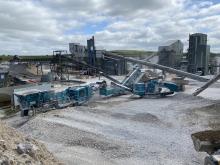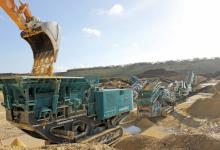
Aggregates consumption in parts of the world is on the increase, offering opportunities for crushing and screening companies. Patrick Smith and Guy Woodford report
An in-depth report published earlier this year claims that the global market for construction aggregates is expected to increase 5.2%/year through to 2015.
Reaching an estimated 48.3 billion tonnes this represents a slower rate of growth than during 2005-2010.
While this reflects a moderation in aggregates-intensive non-building construction activity, nevertheless, demand for construction aggregates will still post solid gains from 2010-2015.
The study, World Construction Aggregates, from the US-based
Eastern Europe and the Africa/Mideast region are expected to undergo significant growth in consumption of construction aggregates, stimulated by infrastructure development projects and strong growth in general economic activity spending.
“Expansions in demand in developed parts of the world, the US, Canada, Japan, Western Europe, South Korea and Australia, will not be as strong as in most industrialising areas,” says the study.
“This is primarily due to the already well-developed infrastructures found in these countries and the construction methods utilised, which tend to feature less concrete.
“Demand for crushed stone, sand and gravel products will post similar growth rates of just over 5%/year through 2015. As in 2010, sand will continue to make up the largest portion of global sales, followed closely by crushed stone and then gravel.”
This is sure to be good news for manufacturers of crushing and screening equipment who are constantly developing and upgrading their equipment.
Of
MacDonald said that impactors are the “machine of the day,” heavily used for recycling with steel content in the feed.
“Germany, Holland and Belgium are big recycling nations and are only going to get more so. In terms of the amount of material recycled, in Holland they will not dig material out of the ground unless they can recycle it.”
Sandvik’s QI240 and QI440 mobile impact crushers are said by the company to be able to achieve superb reduction ratios in a wide range of different applications, with both machines being fitted with under-pan feeders as standard allowing maximum belt protection.
Macdonald said: “It [under-pan feeders] means the conveyor belt does not take the impact of everything the crusher is discharging. The two models’ [discharge] conveyors can be lowered by operators using a remote control.”
Macdonald said the QI240 and QI440 are PLC (Programmable Logic Controller) controlled and come with robust and sophisticated software.
“We have a lot of parameters within the software that allow the machine to regulate the flow of material to give optimum performance,” said Macdonald.
On the UK market for mobile crushing equipment, Macdonald said: “It is very much a jaw and cone market at present, but impactors are coming in more now. One of the factors pushing up demand for impactors for recycling in the UK has been the level of landfill taxes.
“The impactor recycling market is never going to get smaller. Governments are pushing policies where recycling is going to become more and more important.”
Macdonald said that Sandvik is “well on its way” with developing a single-deck hanging screen for its QI240 mobile impact crusher, aiming to complete a prototype by February, 2013.
“It will allow the crusher to produce a sized product. Traditionally you have a crusher that feeds the screen. With a hanging screen you’re putting the screen directly onto the crusher. It will be like having two plants in one.”
Meanwhile,
The pre-screen removes a large percentage of the fines within the feed material before it enters the jaw chamber, resulting in increased output from the machine.
“The pre-screen works effectively in applications where the feed material is dirty. The aggressive nature of the pre-screen means that the dirty material can be screened out before entering the crushing chamber,” says Powerscreen. “The end result is a cleaner crushed product.”
In order to facilitate improved pre-screened material flow, the discharge opening from the under chute has been increased from 200mm to 320mm, allowing faster movement of pre-screened material to bypass the crushing chamber.
To aid the removal of the pre-screened material, the stockpile capacity of new X400S pre-screen side conveyor is 41m3, while the machine also offers quick set-up time; optional improved hopper capacity and a more efficient transfer of screened material to the improved design side conveyor.
“When compared to the standard non-pre-screen X400S, the side conveyor has increased in width from 600mm to 650mm and an improved discharge height of 2.8m creating increased tonnage transfer and stockpile capacity,” says Powerscreen.
“The XA400S pre-screen (with hydraulic adjust) was working at
According to
The trommel, built at the company’s UK plant, has a much-reduced selling price while maintaining its heavy duty tag within the company’s product range.
“During the current economic climate quarries have reduced their overall production levels and also their spending budget for new plant. With these factors in mind Stelex has developed a product that can meet the customer’s needs.
A
The HT152 uses a 1.5m diameter x 8m long barrel to produce up to five product sizes at a feed rate of up to 300tonnes/hour: barrel apertures can be supplied to suit the customer’s exact site requirements. The 40tonne heavy duty wear-resistant feed hopper can be fed directly from a dump truck, and the machine can be mounted on concrete walls or alternatively on a steel under frame with a range of chute options for excellent product separation.
The material feed rate and barrel rotation speed can be regulated to suit requirements through the electric/hydraulic powerpack supplied.
The modular design of the Hercules trommel allows for easy shipping and fast site installation regardless of the site location.
The HT152 fits into the existing range of 1.8m and 2.3m sized mobile and static trommels for a wide range of applications throughout the world.
Meanwhile, Stelex has installed its first trommel, a Hercules HT233, in the Caribbean where it is helping the customer produce clean material sizes from as-blasted and dumped ‘waste’ materials by removing unwanted fines contamination from within the feed.
Mounted on concrete foundations, it is the largest unit in the company’s current production range and is rated up to 1,000tonnes/hour, being fed directly from a fleet of dump trucks.
The 2.3m diameter x 12m long barrel is producing three sizes plus oversize and is specially designed to suit the customer’s individual production requirements and also to meet the site’s demanding weather conditions. The fines material and clean stone is removed from underneath the trommel directly via loading shovels, while oversize stone is rejected from the end of the barrel and collected for further site processing.
The new range of sizes being produced has added new sales possibilities for the customer and further site expansions are being considered to capitalise on these improvements. Pressure on existing conveyors and crushers has also been lifted to due to the removal of the contaminated material making production much more efficient.
The company says the high performance primary mobile jaw crusher is proven in recycling, aggregate production and mining applications.
Excellent material reduction and product sizing in the processing of blasted quarry rock and ore material are offered by the jaw chamber, claims Terex Finlay.
The machine is powered by either a Tier 3/Stage 3A
Hydrostatic transmission of the jaw chamber offers operators reversible operation in the event of a blockage. The hydrostatic system also provides variable chamber speed to suit given applications.
The crusher features hydraulic assist chamber css (closed side setting) adjustment, and can be changed in a matter of minutes.
The machine has a heavy-duty variable speed vibrating grizzly feeder (VGF) with integrated pre-screen, providing an aggressive action to separate fines material efficiently. The variable speed VGF ensures continuous choke feeding of the crushing chamber for optimal productivity. Material from the pre-screen can be diverted to a stock pile via the on-board bypass conveyor or join the crushed product on the main belt.
The large 9.6m³ hopper has hydraulically folding sides and an innovative hydraulic self-locking mechanism to provide efficient and faster machine set up and tear-down times.
“The J-1170’s 45tonne transport weight and compact dimensions mean lower transport costs between and within crushing sites.
“The robust and intelligent chassis design, with good clearance on both ends, also enables safe and easy loading onto all transport trailers. When you combine these factors with the excellent crushing capabilities the machine easily meets the demands of owner-operators and crushing contractors,” said Nigel Irvine, sales and marketing director.
New to the
With a heavy duty cone crusher at its heart (it has a top spider bearing and bottom eccentric bearing design) the crusher’s on-board power comes from a Caterpillar C13 powerpack.
“The tracked cone unit is a robust and uncomplicated design and can work standalone or in circuit with existing crushing and screening plant,” says Tesab.
The 1200mm diameter cone crusher unit features a large opening and can accept up to 250mm feed size, offering a high reduction ratio of up to 16:1.
RG Recycling of County Oxfordshire, UK, in association with McCloskey Equipment and Binder & Co, has launched the McCloskey B200 screener, designed to recover sticky, moist, difficult-to-screen materials, even in poor weather.
With its BIVITEC screen, the B200 uses a high-intensity, high G-force, dual vibration system.
“The system is more efficient than traditional screeners, which encounter a wide range of operating problems, such as blinding, pegging, spillages and blockages, in difficult applications,” says McCloskey.
The new B200 is said to offer screw-less, easy-to-change screen mats that reduce overspill and enhance production with true cut points. It has a wide feeding load and a large screen-box, which maximise its output capacity.
Metso claims that with a 200kW power draw, the GP220 performs at a 20-30% higher capacity than some other cone crushers with equal head diameter.
“The large feed opening enables the feeding jaw crusher to run at 110mm css. Operational flexibility is ensured by multiple strokes and six different cavities,” says the company.
“With advanced automation using IC50 or IC5000, operation is safe and problem-free.”
The Nordberg GP220 weighs 10,500kg and has a maximum real feed size of +200mm with strokes from 18-40mm. The cavity options are EF, F, MF, M, C and EC.
“A complete modular crusher steel structure is available for the GP220 stationary plant installation. The platform includes places for the lubrication unit, motor, automation or pressure accumulator and pressurised sealing. The only things left to add are the feed and discharge conveyors,” says Metso.
With high pressure grinding rolls (HPGR) increasingly becoming a part of hard rock processing due to their energy efficiency, ability to induce micro-cracks and preferential liberation, coupled with high throughput and high reduction ratio, Metso is offering its HRC.
Metso has made several key innovations in order to increase throughput and decrease the total cost of operation.
“Energy efficiency has been attracting our customers to HPGR technology for years,” says Victoria Herman, Metso’s product manager for the HRC.
“But our design concept increases capacity and crushing efficiency, and that’s something mining companies are always looking to improve on.”
The HRC is said to be ideal for high-tonnage, hard rock applications and can be used as a tertiary, quaternary or pebble crusher.










